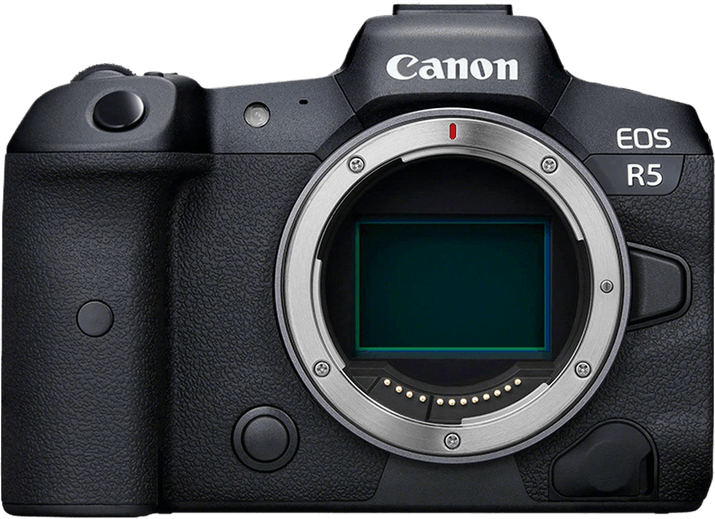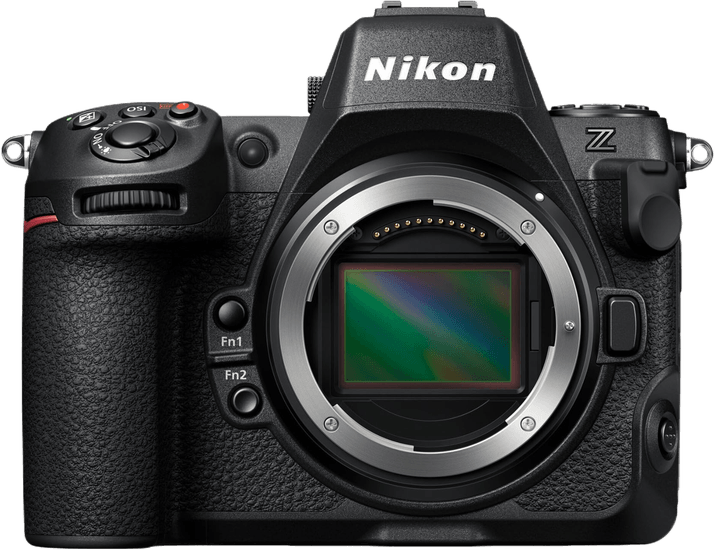Canon EOS R5 vs Nikon Z8 Comparison
Canon EOS R5

Nikon Z8

The Canon EOS R5 outperforms the Nikon Z8 with a score of 86/100 compared to 79/100. Both cameras are mirrorless and were released in 2020 and 2023, respectively. They share similarities in their launch prices, with the R5 at $4499 and the Z8 at $3999.
The EOS R5 excels with its compact size (138 x 98 x 88mm) and lighter weight (680g), making it more convenient for photographers on the go. On the other hand, the Nikon Z8 is slightly larger (144 x 119 x 83mm) and heavier (910g), which may offer better stability during shooting.
Despite the higher score, the Z8 has its advantages, like a lower price, making it a more budget-friendly option. Each camera offers unique benefits, with the R5 providing better portability and the Z8 offering a more affordable choice for photographers.
Canon EOS R5 vs Nikon Z8 Overview and Optics
The Canon EOS R5 and Nikon Z8 both have an optics score of 88/100, indicating they are closely matched in terms of optical performance. Both cameras share several key specifications, including a CMOS sensor, full frame sensor size, and built-in image stabilisation. Additionally, both feature their respective lens mounts, with the Canon EOS R5 utilizing the Canon RF mount and the Nikon Z8 using the Nikon Z mount.
Despite their similar scores, the Canon EOS R5 has certain advantages over the Nikon Z8. The R5 features a Digic X processor, which is known for its fast processing speed and excellent image quality. This camera also boasts a respectable 45-megapixel resolution and a shooting speed of 20 frames per second, which is suitable for capturing fast-moving subjects.
On the other hand, the Nikon Z8 outperforms the Canon EOS R5 in some areas. It has a slightly higher resolution with 46 megapixels, and a faster shooting speed of 30 frames per second. The Z8 also has a higher DXOMARK sensor score of 98, compared to the R5’s score of 95. This suggests that the Nikon Z8 may produce better image quality and dynamic range. Furthermore, the Nikon Z8 features the Expeed 7 processor, which is also known for its fast and efficient performance.
Taking these factors into consideration, it is clear that both the Canon EOS R5 and Nikon Z8 offer high-quality optics and performance. The Canon EOS R5 may be more suitable for those who prioritize processor capabilities, while the Nikon Z8 could be a better choice for those seeking higher resolution and faster shooting speeds. Ultimately, the decision between these two cameras will depend on individual preferences and specific needs.
Canon EOS R5 vs Nikon Z8 Video Performance
Both the Canon EOS R5 and the Nikon Z8 achieve a perfect video score of 100/100, highlighting their impressive video capabilities. The two cameras share many common specifications, including 8K maximum video resolution, 120fps maximum video frame rate, and built-in time-lapse functionality. These features make them suitable for professional videography and high-quality video production.
The Canon EOS R5 edges ahead with its higher maximum video dimensions of 8192 x 4320 compared to the Nikon Z8’s 7680 x 4320. This difference results in slightly better video quality, providing more detail and clarity in the footage captured by the EOS R5. This advantage makes the Canon EOS R5 the better choice for videographers who prioritize resolution and image quality in their work.
On the other hand, the Nikon Z8 still offers remarkable video performance with its 8K resolution and 120fps frame rate. While it may not surpass the Canon EOS R5 in terms of video dimensions, it remains a strong contender for those who require high-quality video capabilities. The Z8’s performance should not be overlooked and may be more than sufficient for most videographers’ needs.
Taking these points into consideration, the Canon EOS R5 emerges as the superior option for videographers who prioritize maximum video dimensions and overall image quality. However, the Nikon Z8 remains a competitive choice for professionals who require exceptional video capabilities without the need for the highest possible video dimensions. Both cameras are undoubtedly impressive, but the Canon EOS R5’s slight advantage in video dimensions makes it the preferred choice for those focused on video quality.
Canon EOS R5 vs Nikon Z8 Features and Benefits
The Canon EOS R5 wins in the features comparison with a score of 87/100, while the Nikon Z8 scores 61/100. Both cameras share some common specifications, such as a 3.2-inch screen size, touchscreen capability, absence of GPS, and WIFI connectivity. However, there are also notable differences that set them apart.
The Canon EOS R5 outperforms the Nikon Z8 in multiple areas. Firstly, the EOS R5 has a slightly higher screen resolution at 2,100,000 dots, compared to the Z8’s 2,088,960 dots. This difference results in a marginally better display quality for the EOS R5. Secondly, the EOS R5 features a flip screen, enhancing its versatility for various shooting angles and situations. Lastly, the EOS R5 includes Bluetooth connectivity, providing an additional option for users to connect and transfer files with ease.
On the other hand, the Nikon Z8 falls short in a few aspects. It lacks a flip screen, which limits its flexibility in certain shooting scenarios. Additionally, the Z8 does not have Bluetooth connectivity, which may inconvenience some users who prefer this mode of connection.
Despite these differences, both cameras offer impressive specifications and features for photographers. The Canon EOS R5 stands out with its higher feature score, flip screen, and Bluetooth connectivity, making it a more versatile and user-friendly option. Conversely, the Nikon Z8 still provides a solid set of features, though it may not be as well-rounded as the EOS R5. Ultimately, the choice between the two cameras will depend on the user’s preferences and priorities in terms of features and functionality.
Canon EOS R5 vs Nikon Z8 Storage and Battery
The Canon EOS R5 and Nikon Z8 both score 68/100 in storage and battery, indicating no clear winner. Both cameras feature two memory card slots and accept SD, SDHC, SDXC (UHS-II compatible), and CFexpress cards. USB charging is also available on both models.
The Canon EOS R5 has a battery life of 320 shots and uses an LP-E6NH battery, while the Nikon Z8 has a slightly longer battery life of 340 shots and utilizes an N-EL15c battery. This difference in battery life gives the Nikon Z8 a slight advantage in this category.
However, the Nikon Z8 also accepts XQD memory cards, offering additional flexibility in storage options compared to the Canon EOS R5. This feature makes the Nikon Z8 slightly superior in terms of storage capabilities.
Despite these minor differences, both cameras perform similarly in storage and battery capacities. Users should consider other factors, such as optics, video, and features, when deciding between the two models.
Canon EOS R5 vs Nikon Z8 – Our Verdict
Are you still undecided about which camera is right for you? Have a look at these popular comparisons that feature the Canon EOS R5 or the Nikon Z8:

